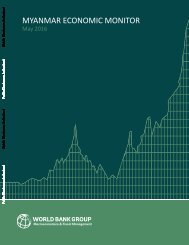Myanmar
1WZPRL1Jj
1WZPRL1Jj
- No tags were found...
Create successful ePaper yourself
Turn your PDF publications into a flip-book with our unique Google optimized e-Paper software.
MYANMAR BUSINESS SURVEY: DATA ANALYSIS AND POLICY IMPLICATIONS<br />
tourism and foreign enterprises) and industrial zones<br />
(OECD, 2013 and 2015). As a result, the country’s<br />
regulatory and policy framework remains fragmented<br />
and less transparent, with businesses having to deal<br />
with a number of parallel line ministries that often fail<br />
to adequately coordinate activities between themselves<br />
(OECD, 2013).<br />
One of the consequences of the present regulatory<br />
framework is that the informal sector has become<br />
large and diverse, comprising everything from small<br />
family businesses to large enterprises (OECD, 2013).<br />
Small informal firms tend to have low productivity and<br />
inadequate access to financing while large informal<br />
firms may avoid paying tax which leads to less revenue<br />
for the Government and unfair competition for formal<br />
businesses. A transition to the formal economy is<br />
essential for <strong>Myanmar</strong>’s development, and this will<br />
require the Government to pay greater attention to<br />
the regulatory framework in particular and business<br />
environment more generally (Abe, 2014).<br />
2. Market conditions<br />
<strong>Myanmar</strong> has a population of 51.4 million and is the<br />
second-largest country in South-East Asia in terms<br />
of geographical territory. Although it is categorized in<br />
the low-income group as a least developed country,<br />
the country is rich in natural resources and fertile<br />
terrain, with large agricultural areas. <strong>Myanmar</strong> is part<br />
of ASEAN and strategically located between two<br />
giant markets, China and India, which enable it to<br />
benefit from a rapidly growing Asia that is likely to<br />
become the most prosperous region in the world in<br />
the next few decades. Thus, the country has much<br />
untapped potential for future growth and development<br />
(ESCAP, 2015).<br />
The favourable geostrategic characteristics and<br />
location of <strong>Myanmar</strong> offer the country an opportunity<br />
to become a major production hub in the region and<br />
a key exporter to its high-growth neighbours (e.g.,<br />
other ASEAN members). The country borders not<br />
only the major markets of China and India but also<br />
the emerging markets of Bangladesh, the Lao PDR<br />
and Thailand. The integration of ASEAN into one<br />
economic community (i.e., AEC) offers <strong>Myanmar</strong> the<br />
opportunity to benefit immensely from integration with<br />
subregional, regional and global economies (ADB,<br />
2012). <strong>Myanmar</strong> could potentially join regional business<br />
and production networks by strengthening trade and<br />
investment ties with other ASEAN members (ADB,<br />
2012). The McKinsey Global Institute (MGI) (2013) has<br />
estimated that by 2025 the country will be within a<br />
five-hour plane ride of 2.5 billion consumers.<br />
These opportunities, however, come with challenges<br />
as an open border will bring greater competition to<br />
local firms that have been shielded for decades. SMEs<br />
are particularly vulnerable as they are not prepared to<br />
face the global transformation of business strategies<br />
and practices (Abe and Dutta, 2014). This means<br />
that they might lose market share domestically while<br />
being unable to take advantage of the benefits that<br />
integration provides. It therefore becomes all the more<br />
essential for SMEs as well as larger firms to enhance<br />
their competitiveness, product quality and management<br />
practices so that they can integrate seamlessly into<br />
the global economy (Abe and Dutta, 2014). At the<br />
same time, the Government of <strong>Myanmar</strong> will have<br />
to work hard to enhance the competitiveness of<br />
local business by (a) upgrading various key factors<br />
such as infrastructure, human resources, technology<br />
and business development services, and (b) further<br />
liberalizing trade and investment together with the<br />
implementation of trade facilitation measures (ESCAP,<br />
2015).<br />
3. Innovation<br />
Innovation and technology are widely regarded as<br />
essential to quickening the pace of development<br />
and growth in any country. Increasing productivity<br />
and competitiveness as well as developing innovative<br />
products are all the more important to gain market<br />
share overseas and to resist domestic competition.<br />
The use of transformative technologies such as the<br />
Internet has been shown to have dramatic effects on<br />
GDP growth. A World Bank study of 120 low- and<br />
middle-income countries found that a 10 per cent<br />
increase in broadband penetration between 1980 and<br />
2002 yielded an additional 1.38 per cent in GDP<br />
growth (Qiang and Rossotto, 2009). Another study<br />
(MGI, 2012) estimated that the Internet had accounted<br />
for as much as 12 per cent of cumulative GDP<br />
growth during the previous five years in a group of<br />
developing countries.<br />
Given the potential of the Internet and other technologies,<br />
it is unclear whether <strong>Myanmar</strong> businesses are utilizing<br />
those technologies to their full potential. Furthermore,<br />
investment in research and development (R&D) remains<br />
low in <strong>Myanmar</strong>, which is particularly problematic<br />
6







